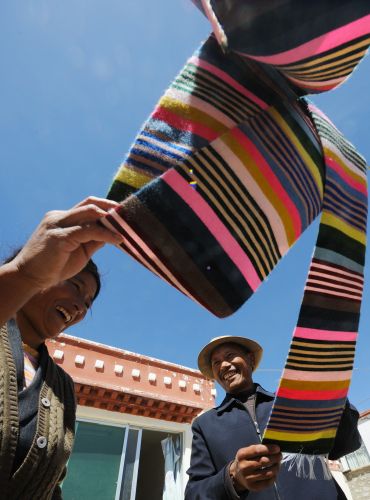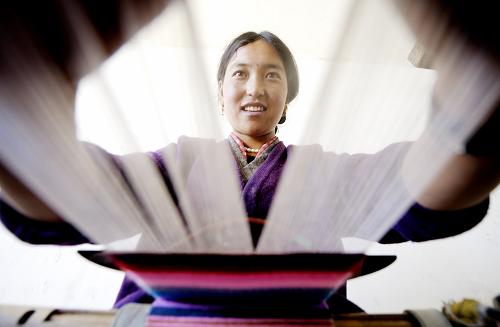Bangdian: beautiful ornament for Tibetan women

Bangdian is a unique mark of Tibetan women’s garments. It was originally a kind of colorful pulu fabric with fine horizontal lines (raw material of Tibetan robe), but later became an ornament tied by Tibetan women around the waist, thus known as a pronoun of Tibetan apron.
This kind of fabric is used by Tibetans to make sleeveless jackets, aprons, satchels or edges of Tibetan robe for women. Modern people also use it to decorate the walls of living room.
There are many kinds of Bangdian; the best is “Xiema”, woven elaborately with 14-20 kinds of dyed wool yarns.
The production process is not simple: select superior wools, comb and twist them into yarns, weave them into fabric with patterns via loom, size and dye it repeatedly, rub it and finally hang it up to dry. As for dyeing, special Tibetan rock and vegetable dyes made by folk craft can produce over 20 kinds of bright colors, which will not fade. Twisting yarns is a time-consuming and strenuous job, so women have done the job and men woven yarns into fabric since ancient times.
Bangdian was initially used to keep dust from robe as an apron, but later became an important part of Tibetan women's clothing. The traditional Bangdian was woven with fine colored yarns, often forming a strong contrast in color, rough and bright. Now, it usually adopts fine related colors, looking elegant and mild. It is said that the production method of Bangdian was closely related to Princess Wencheng who brought lots of dyes to Tibet and taught the dyeing method to Tibetans.

Bangdian is also a sign of a girl’s turning mature. After a Tibetan girl reaches the age of 15, her family will choose an auspicious day to hold a coming-of-age ceremony for her. As a main part of the ceremony, she would be asked to wear Bazhuka on her head and tie a colored Bangdian around her waist. Then, she would receive an elder’s hada scarf and blessings. This day heralds the maturity of the girl.
In addition, influenced by Tibetan Buddhism, Tibetan women’s garments adopt five bright colors boldly. From the Buddhist perspective, colorful hada is the eye makeup of Bodhisattva. Blue, white, green, red and yellow represent blue sky, white cloud, river, guardian god in charge of space and land respectively. Based on the five colors, Bangdian combines various colored stripes. Some women in northern Tibet also inlay five-cm-wide Bangdian fabric in front of the robe and then make patterns 3-14 cm wide with red, blue, yellow, purple, black and other colors.
Deshol Town of Gangkar County in Shannan Prefecture of Tibet is a major producing area of Tibetan aprons, thus enjoying the reputation of the “town of Bangdian”.

Your Comment
Name E-mailRelated News
-
;
-
-

-
Tibetan special fabric: pulu
Pulu is a kind of traditional Tibetan woolen fabric, and mostly used for making Tibetan carpets, curtains, robes, clothes or boots.
-
-
-
Pulu weaving develops in Chanang
Pulu (woolen fabric) weaving industry is developing fast in Chanang County.
-
-
-
Pulu weaving increases farmers' income
Nyima Drolkar is busy in weaving pulu (woolen fabric) during the slack season in order to increase income.
-
Based in Lhasa, Tibet Vista is a Tibet travel agency that specialized in Tibet permit, and Tibet tours for both private and group travelers at a local price!
•4 Days Lhasa City Group Tour from USD 460 •8 Days Everest Base Camp Group Tour from USD 850 •15 Days Mt.Kailash Group Tour from USD 1780 •2016 Tibet Train Tours from Beijing, Shanghai, Chengdu, Xining,etc










